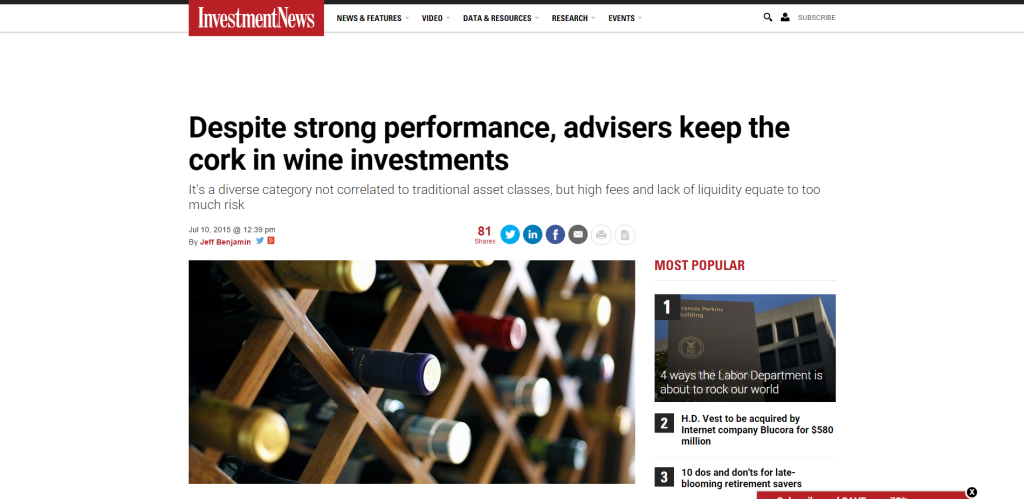In a recent edition of Investment News, Sullivan Financial Planning’s Kristi Sullivan was quoted for the article, Advisers Preach Calm, Buckle in as Markets Bounce by Jeff Benjamin. A copy of the article is below.
Advisers preach calm, buckle in as markets bounce
Prepare clients for market volatility by thinking long term and being proactive
By Jeff Benjamin | January 8, 2015 – 11:49 am EST
Financial advisers aren’t exactly shrugging off the recent bout of stock market volatility that has ushered in the New Year, but they’re also not ready to call it the start of a much larger pullback that should be addressed with portfolio adjustments.
“I’m a buy-and-hold and rebalance kind of gal, and I tell my clients we’re in it for the long run,” said Kristi Sullivan, owner of Sullivan Financial Planning.
Like a lot of financial advisers over the past few weeks — since the Dow Jones Industrial Average peaked above 18,000 and has since fallen below the latest milestone — Ms. Sullivan is reminding clients to keep things in perspective.
“Even though the total points look big, percentage wise, the moves are not really that big,” she added.
Both the Dow and the closely-watched S&P 500 Index opened on Thursday down less than 1.5% from the start of the year, which is described by some advisers as a normal January pullback in the wake of a 14% gain for 2014. And by midday Thursday, both market gauges were trading higher and had erased their 2015 losses.
“I think we’re going to continue to experience this kind of volatility for the first half of the year, and then the market will gravitate upwards,” said Robert Foley, an adviser with Raymond James.
Even though Mr. Foley believes the January market volatility is a logical reality of tax management and rebalancing during periods of low-volume trading, he employs a proactive approach with clients in times like these.
“When there is this kind of volatility, I’m calling them, I’m not waiting for them to call me,” he said. “Most of my clients will say they’ve been watching it and paying attention, but that they are fine.”
In many respects, investors might have gotten spoiled by the stock market’s general strength and relative calm over the past few years. It has been more than three years since the U.S. stock market has experienced a decline of 10% or more.
Such market corrections historically have happened about once every 18 months.
What’s more is that there are a few fresh catalysts for a pullback, including the rapidly declining price of oil, which feels good at the gas pump but has several potential macro-market and economic repercussions.
“Clearly, oil is the sound bite, but market volatility is something I think we’ll see throughout the year,” said Dorothy Weaver, chairman and chief executive of Collins Capital.
The stock market volatility, which has been illustrated by a string of 200-plus point daily swings by the Dow over the past week, is a result of financial markets, assets and global central bank policies falling abruptly out of sync, she explained.
“We’re coming off a period of historically low volatility when everything was synchronized and there was the assumption that the Fed would take care of everything,” Ms. Weaver said. “Now, it is becoming much more about divergence among asset classes, sectors and even countries, and the strength of the dollar is part of that divergence.”
The surging strength of the U.S. dollar is part of the global divergence because it will hamper exporting economies pegged to it.
Measured in an October survey of more than 5,200 CFA Institute members from around the world, the advice industry has become largely bullish on everything except the price of oil.
According to the findings, which were released in December, the respondents are expecting a positive year for gold and U.S. Treasury bonds, as well as stocks in the U.S., Europe and Japan.
The respondents expected the price of oil, which was trading at around $95 a barrel when they were surveyed in October, to fall to around $91 in 2015. But the commodity has since fallen to below $49 a barrel.
In terms of individual stock market potential, more than a third of the respondents identified the U.S. market as the best place to invest in 2015, followed by China, which was favored by 9.3%, India, 8.9%, and Russia, 6.2%
That compares with a year ago, when 26.3% of respondents favored U.S. stocks, followed by 10.7% for China, 6.2% for Japan and 6.1% for Germany.
“People see the headwinds with things like the emerging markets slowing down, and geopolitical unrest, but when asked which markets to invest in, the U.S. comes out on top again,” said Matt Orsagh, director of capital markets policy at CFA Institute.
Brian Power, chief operating officer and co-founder of Gateway Advisory, said he plans to put all the crosswinds into perspective for clients as he starts scheduling annual reviews this month.
“Most of our clients haven’t even realized the markets have been down because their performance reports aren’t reflecting it yet, but as we start having client reviews we’ll definitely be having those conversations,” he said. “I think people will be relatively pleased with how they did last year, but we haven’t had any real volatility in so long, I think investors have been getting lulled to sleep a little bit.”
Mr. Power admits he didn’t expect to see the abrupt market movements that kicked off the year.
“Overall, I was a little surprised by the swiftness of some of the pullbacks, but the pendulum always swings too far one way or the other,” he added. “And these sudden pullbacks are fine by me because I’d rather see that than several down months of stocks slowly correcting.”
While some advisers have found that investors have become more conservative and attuned to risks since the 2008 financial crisis, David Schneider, founder of Schneider Wealth Strategies, believes his clients have hardened to volatility since the market’s low point in March 2009.
“I don’t think we’ve had enough downside volatility to really distress people yet,” he said. “The people who made it through the financial crisis have become somewhat numb to short downside moves and I think it will take more than a few days or weeks of this to really concern people.”
Keeping market moves in perspective is a large part of helping clients deal with volatility, according to Charles Sachs, president of Private Wealth Counsel.
“Investors don’t mind market volatility, they mind downside volatility,” he said. “On the downside, I remind people that it’s a great time to add to your portfolio and that they should be embracing some of this volatility, because if there’s no volatility in your portfolio it’s just a certificate of deposit.”
When dealing with clients at times like these, Mr. Sachs tries to keep the focus on the long-term view.
“If you’re 50, and you’re going to live another 40 years, you have to ask yourself what is actionable about a market pullback,” he said. “It’s a marathon not a sprint, and perspective goes a long way.”
Stay Informed and Educated — Subscribe to the SFP Blog! Use the quick and easy form to the right of this article.



